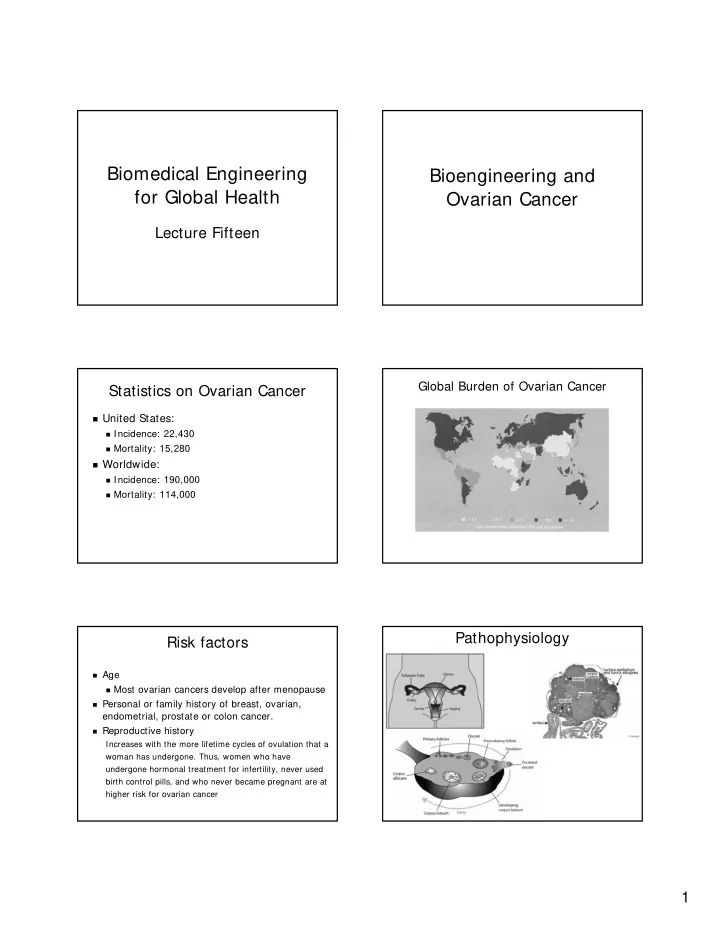

Biomedical Engineering Bioengineering and for Global Health Ovarian Cancer Lecture Fifteen Global Burden of Ovarian Cancer Statistics on Ovarian Cancer � United States: � Incidence: 22,430 � Mortality: 15,280 � Worldwide: � Incidence: 190,000 � Mortality: 114,000 Pathophysiology Risk factors � Age � Most ovarian cancers develop after menopause � Personal or family history of breast, ovarian, endometrial, prostate or colon cancer. � Reproductive history Increases with the more lifetime cycles of ovulation that a woman has undergone. Thus, women who have undergone hormonal treatment for infertility, never used birth control pills, and who never became pregnant are at higher risk for ovarian cancer 1
Transvaginal Sonography Screening of Ovarian Cancer � Pelvic and rectal exam � CA125 test � Transvaginal sonography Nucleus Medical Art www.ivf-infertility.com. Diagnostic Laparoscopy Detection and Treatment � Screening Complication Rate = 0.5 – 1% � Pelvic exam � CA125 test � Transvaginal ultrasound � Diagnosis � Diagnostic laparoscopy � Treatment: Allon Health Center - Center for Women's Medicine John P.A. George, M.D., Washington Hospital Center � Surgery, radiation therapy, chemotherapy � 5 year survival � Localized disease: 93% (20% diagnosed at this stage) Screening Scenarios Screening Scenarios � Scenario # 1: � Scenario # 2: � Screen 1,000,000 women with CA125 � Screen 1,000,000 women with transvaginal US � p = .0001 (100 cancers) � P = .0001 (100 cancers) � Se= 35% , Sp= 98.5% � Se= 100% , Sp= 96% � Cost = $30 � Cost = $150 � Follow with laparoscopy � Follow with laparoscopy � Complication rate = 1% � Complication rate = 1% � Cost= $2,000 � Cost= $2,000 � TP= 35 FP= 14,999 Complications= 150 � TP= 100 FP= 39,996 Complications= 401 � PPV = 0.23% NPV = 99.99% � PPV = 0.25% NPV = 100% � Cost per cancer found = $1,716,200 � Cost per cancer found = $300,672 2
Screening Scenarios Screening Scenarios � Scenario # 3: � Scenario # 3 cont.: � Screen 1,000,000 women > age 50 with TVUS � Screen 1,000,000 women > age 50 with TVUS � P = .0005 (500 cancers) � P = .0005 (500 cancers) � Se= 100%, Sp= 96% � Se= 100% , Sp= ??% � Cost = $150 � Cost = $150 � Follow with laparoscopy � How high does Sp need to be for PPV to reach � Complication rate = 1% 25%? � Cost= $2,000 � Sp = 99.985% � TP= 500 FP= 39,980 Complications= 405 � PPV = 1.24% NPV = 100% � Cost per cancer found = $60,670 Ongoing Clinical Trials Does Ultrasound Screening Work? � United Kingdom � Two studies of over 10,000 low-risk women: � 200,000 postmenopausal women � CA 125 level plus transvaginal ultrasound examination � The positive predictive value was only 2.6% � Transvaginal ultrasound alone � Ultrasound screening of 100,000 women over � No screening age 45 would: � United States: � 37,000 women (aged 55–74) � Detect 40 cases of ovarian cancer, � Annual CA 125 level and transvaginal ultrasound examination � Result in 5,398 false positives � No screening � Result in over 160 complications from diagnostic � Europe: laparoscopy � 120,000 postmenopausal women � No screening, � Jacobs I. Screening for early ovarian cancer. � Transvaginal ultrasound at intervals of 18 months Lancet; 2:171-172, 1988. � Transvaginal ultrasound at intervals of 3 years http://www.mja.com.au/public/issues/178_12_160603/and10666_fm.pdf Ovarian Cancer Challenge Better screening methods to detect early Risk factors stages of ovarian cancer Detection Treatment Challenges New technologies 3
Data Analysis Cancer Screening Exams Training Validation � Cellular/Morphological Markers � Pap smear � Serum protein markers � PSA � CA125 � DNA markers � HPV DNA OvaCheck � Quest Diagnostics and LabCorp: � Will analyze blood samples sent by doctors, rather than sell test kits to doctors and Useful M/Z: hospitals 534 � Tests performed at a central location do not 989 require F.D.A. approval 2111 � Cost: $100-$200 2251 2465 The Lancet , 2002, Vol. 359 No. 9306, pp. 572–577 Comparative Analysis Lance Liotta, lead author: "The most important next goal is validating the promise of these results in large, multi- institutional trials.” Useful M/Z: 534 989 2111 2251 2465 The Lancet, 2002, Vol. 359 No. 9306, pp. 572–577 Bioinformatics (Oxford, England) . 2004 Mar 22; 20 (5): 777–85. 4
Response New screening technologies � Dr. Eleftherios P. Diamandis, head of clinical biochem at � New screening technologies Mount Sinai Hospital in Toronto. � Proteomics � "If you don't know what you're measuring, it's a dangerous black-box technology… They are rushing into something and it � DNA microarrays could be a disaster.“ � Dr. Nicole Urban, head of gynecologic cancer research at � Optical technologies the Fred Hutchinson Cancer Research Center in Seattle. � "Certainly there's no published work that would make me tell a woman she should get this test.“ � Dr. Beth Karlan, director of gynecologic oncology at Cedars-Sinai Medical Center � "Before you mass-market to the uninformed, fearful population, it should be peer-reviewed," � When asked whether she would recommend her patients not get tested, she said: "It doesn't matter what I recommend. They are going to do it anyway." 5
Recommend
More recommend